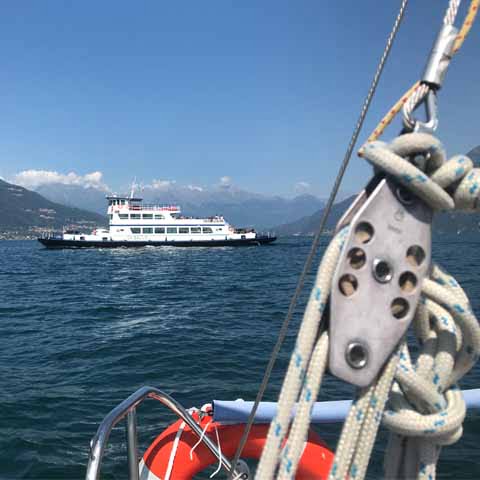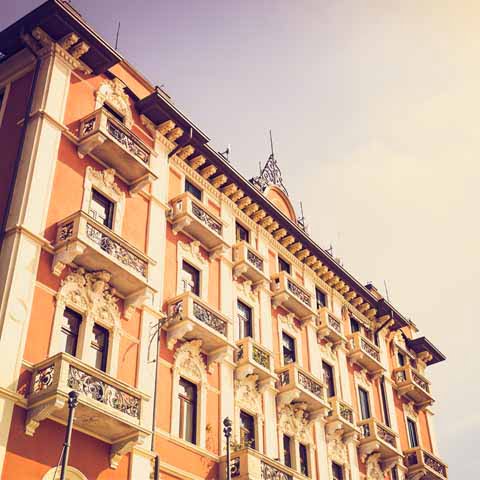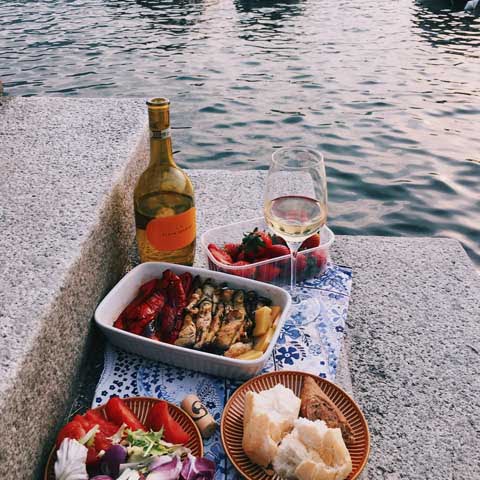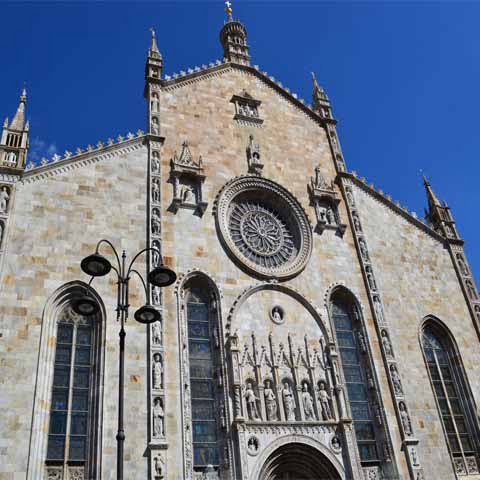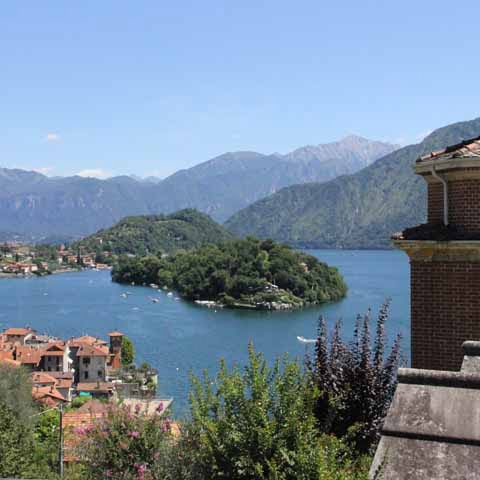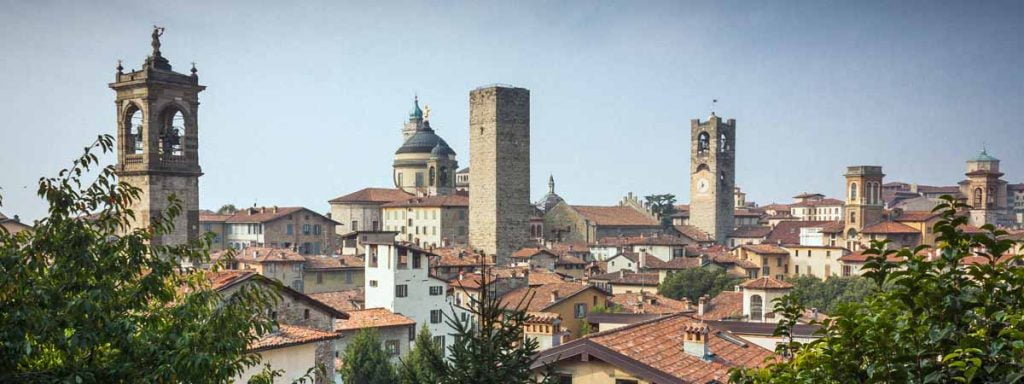Just south of the border with Switzerland in the far northern portion of Italy, is the enchanting city of Como. The city is located on the southern part of Lake Como and is known for its natural beauty as it is nestled between the mountains and the lake. For this reason, the city has long been a draw for celebrities and travelers hoping to escape the demands of city life. In Como, visitors will find a charming town full of warm people and strong Italian character. Whether you seek the ornate and detailed architecture of local churches and monuments or fine art found in the galleries, Como is rich in both tradition and culture, making it one of the loveliest places to visit in Northern Italy.
ARCHITECTURE
The Como Cathedral of Santa Maria Assunta is an outstanding and breathtaking example of Gothic architecture in Italy. The structure is a labor of love that was started in the late fourteenth century and took an estimated four hundred years to complete. At well over two hundred eighty feet tall, the cathedral has a commanding presence, and its exterior features dozens of carved statues, long arched windows, ornate doorways, and a rose window.
Just outside of Como sits the Basilica of Sant’Abbondio. The Romanesque church is dedicated to Sant’Abbondio, a former Como bishop, and has received many renovations and updates over the years. In the early eleventh century, the basilica was consecrated by Pope Urban II. The Basilica of Sant’Abbondio’s exterior is primarily a whitewashed gray with two distinct bell towers and a main apse. The interior of the church features fourteenth century frescoes and a main aisle flanked with grand columns and archways.
The Basilica of San Fedele can be found in the heart of Como. This beautiful church almost appears to be standing sandwiched between buildings. The exterior of the basilica consists of one tall bell tower with several arched windows as well as the main entrance to the church, which features a very large and central rose window and ornate entryway. The basilica has been rebuilt and modified over the years after damage from an earthquake and the ravaging effects of time. Intricate frescoes, an exquisite marble altar, and multiple chapels create a feeling of reverence within the basilica’s walls.
The Basilica of San Carpoforo has roots that trace all the way back to the fourth century. However, the structure we see today is a product of the eleventh century renovations made to the church. The beige stone exterior consists of one main bell tower with several arched windows, and below it, a smaller and more rounded main area. The interior is decorated in simplicity with clean lines and unadorned archways, but does feature several beautiful frescoes.
In addition to the above architecture found in churches, do not miss the ancient medieval walls and towers of Como. These walls were originally built in the first century under Roman rule, but were later destroyed in the early twelfth century by war. In the subsequent years, the walls were modified and restored to the structure seen today.
Another historic defensive structure is the Castello Baradello. Perched on a hill above the city of Como, Castello Baradello offers wonderful panoramic views of the lake, the city of Como, and the peaks of the Alps as well as the Po Valley and even the Apennine Mountains. Dating back to the sixth century, the castle’s best-preserved feature is the square tower, which, at ninety feet tall, continues to watch over the city of Como.
In addition to religious and defensive structures, the Lake Como area is, of course, primarily known for its stunning villas. The city of Como is no exception as it is home to Villa Olmo, a beautiful Neoclassical villa commissioned by Marquis Odescalchi. Built on the western edge of Lake Como, Villa Olmo provides excellent views of the lake and surrounding mountains. Also on the grounds is an extensive park—the perfect place to relax amid the remarkable scenery. Over the years, several illustrious guests have visited Villa Olmo including Napoleon, influential Italian writer Ugo Foscolo, and Giuseppe Garibaldi.
Looking past the more historic architectural styles, Como is also one of the Northern Italian cities with excellent examples of modern Rationalist architecture, which was popular in Italy during the 1920s and 1930s. Featuring Neoclassic influences with an emphasis on simple shapes and a form that represents function, Como’s Rationalist buildings are distinct from the rest of the city’s architecture. Several of the key Rationalist structures in Como include the Camerlate Fountain, Sant’Elia Kindergarten, and Palazzo Terragni, which is considered to be the magnum opus of master Rationalist architect Giuseppe Terragni.
ART
Over the centuries, the beauty of the Lake Como area, with its unique landscapes composed of mountains reflected in the waters of the lake, has inspired countless writers, poets, and artists. One excellent example is American nineteenth and twentieth century artist Charles Warren Eaton. Renowned for his tonalist landscapes, Eaton frequently depicted the bright colors of Lake Como’s landscapes in his works.
Twentieth century painter Mario Radice was born in Como. Radice is primarily remembered for being one of the first of his peers to leave figurative art for the European movement of abstract art. Although many of the artist’s abstract frescoes were destroyed in World War II, some can still be found today. The neighboring city of Milan displayed his works in the early twenty-first century and his art can often be found at art exhibitions in Turin and Rome as well.
Another twentieth century abstract painter is Manlio Rho, who was born in Como and thought to be one of Italy’s most prominent abstract artists. Most of his works are characterized by flat geometric shapes in green, brown, and orange colors. As with Radice, Rho’s works can often be found on display in Milan, Rome, Trento, and Trieste.
A contemporary of architect Giuseppe Terragni as well as artists Mario Radice and Manlio Rho, Antonio Sant’Elia was an influential painter and architect born in Como towards the end of the nineteenth century. An important member of the futurist movement, Antonio Sant’Elia’s sketches and designs had a strong impact on Italy’s twentieth century architecture. Though his artistic career was cut short after his death in battle during World War I, his ideas lived on in the futurist movement. His futurist vision can be identified in later works by Giuseppe Terragni as well as Art Nouveau architecture and even the dystopian science fiction film Blade Runner.
The city is home to a fabulous art gallery called Pinacoteca Civica. As many Italian galleries and museums are, Pinacoteca Civica is housed inside a historic palace, the Palazzo Volpi from the seventeenth century. The museum’s collection is exhibited in ten rooms that are categorized by theme. When touring this gallery, expect to see masterpieces from the medieval and Renaissance periods along with more contemporary paintings and sculptures by the likes of artists such as Mario Radice, Manlio Rho, and other artists active in Como during the nineteenth century.
During a visit to the Museo Didattico della Seta di Como (the Educational Silk Museum) curious travelers can learn more about Como’s great artform: silk production. Since the fifteenth century, the city of Como has been at the center of Italy’s silk production. The Educational Silk Museum explores the history of silk production in Como as well as the processes involved to make silk. Also on display are gorgeous garments and accessories designed by Como’s master silk makers over the centuries.
SCIENCE
Como is the birthplace of famed Italian scientist Alessandro Volta. A gifted physicist and chemist, Volta made indispensable contributions to our current understanding of power and electricity. Among his pioneering works, Volta is credited with the invention of the electric battery and the discovery of methane gas.
LITTERATURE
Gaius Plinius Secundus, more commonly known as Pliny the Elder, was a well-known Roman author and philosopher of the first century. His writings were largely a compilation of history and biographies of respected citizens. Pliny the Elder’s best-known work is Naturalis Historia, an ancient basis for future encyclopedias that gathered the sum of ancient knowledge featuring topics such as mathematics, agriculture, astronomy, and more.
Pliny the Elder’s nephew, Gaius Plinius Caecilius Secundus, also known as Pliny the Younger, was a writer as well. He wrote hundreds of letters, some of which have survived the centuries, to emperors and prestigious heads of government. In addition, he is thought to have written many poems and orations. One of his only surviving orations is the Panegyricus Traiani, which was said to have been presented to the Senate in the first century. Among his most important surviving letters are two letters that describe the eruption of Mount Vesuvius in 79 AD, which claimed the lives of many Roman citizens including that of his uncle, Pliny the Elder.
Como was also home to twentieth century Italian essayist and poet, Carla Porta Musa. Musa was the author of La Luna di Traverso and several other twentieth and twenty-first century essay collections, novels, and poetry books. Her other claim to fame was becoming one of Italy’s supercentenarians and living a long and full life until the age of 110.
MUSIC
It’s no secret that famed Hungarian composer Franz Liszt was one of Lake Como’s many admirers. Having spent time in the tranquil Lake Como area as well as the city of Como, it is believed that the stunning panoramas provided inspiration to Liszt. In Como, Liszt is known to have performed at the Teatro Sociale a few days after the birth of his daughter Cosima on Christmas Eve in 1837. Cosima, who was born in a Como hotel, would eventually marry German composer Richard Wagner and serve as inspiration for his operas.
Como was also the birthplace of violinist and opera singer Carolina Ferni. During her career, Ferni performed in Italy’s most prestigious theaters including Teatro alla Scala in Milan and Teatro Regio in Turin. She was also a gifted teacher, and her students included famed tenor Enrico Caruso as well as her son, Eugenio Giraldoni, who was also an opera singer.
Floraleda Sacchi is a famous Italian harpist and composer from Como. Sacchi is an accomplished harpist that has studied, competed, and performed around the world. She primarily plays the pedal harp. Because of her accomplishments and success, Sacchi has served as the artistic director of the Lake Como Festival.
Como is also the site of the Como Città della Musica Festival, a summer concert series organized by the city’s Teatro Sociale. Taking place in the month of July, the festival consists of concerts held in some of the Como’s most picturesque locations including Villa Olmo and Castello Baradello. The concerts focus on classical, opera, and jazz music, and feature both Italian and international musicians.
CINEMA
The greater Lake Como area has a rather strong presence in the cinematic industry. Blockbusters such as Star Wars: Episode II — Attack of the Clones (2002), Ocean’s Twelve (2004), and Casino Royale (2006) all include scenes filmed in the Lake Como area. Additionally, Italian film Il capitale umano (2013) as well as Murder Mystery (2019) and The Burnt Orange Heresy (2019) were partly filmed in the city of Como as well as other towns of the Lake Como area.
The historic city of Como not only serves as a gateway to the picturesque lake area with which it shares a name, but it is also full of rich culture that has inspired artists, authors, and musicians for centuries. From the exquisite architecture to the lovely art and unmatched scenery, the beauty of Como and its lake is boundless, leaving a lasting impression on all who visit.
Don't just see Italy, live it.
Your dream trip to Italy has never been closer
No more endlessly scrolling travel sites. Our travel experts will craft the perfect, one-of-a-kind trip just for you.

300+
DESTINATIONS
We offer more Italian destinations than any travel site. Do and see more with Trips 2 Italy.
1 (of a kind)
ITINERARIES
Because your dream trip to Italy should be designed for you, not for the masses.
100%
PEACE OF MIND
From flights and accommodations, to food and activities - we take care of every detail.
